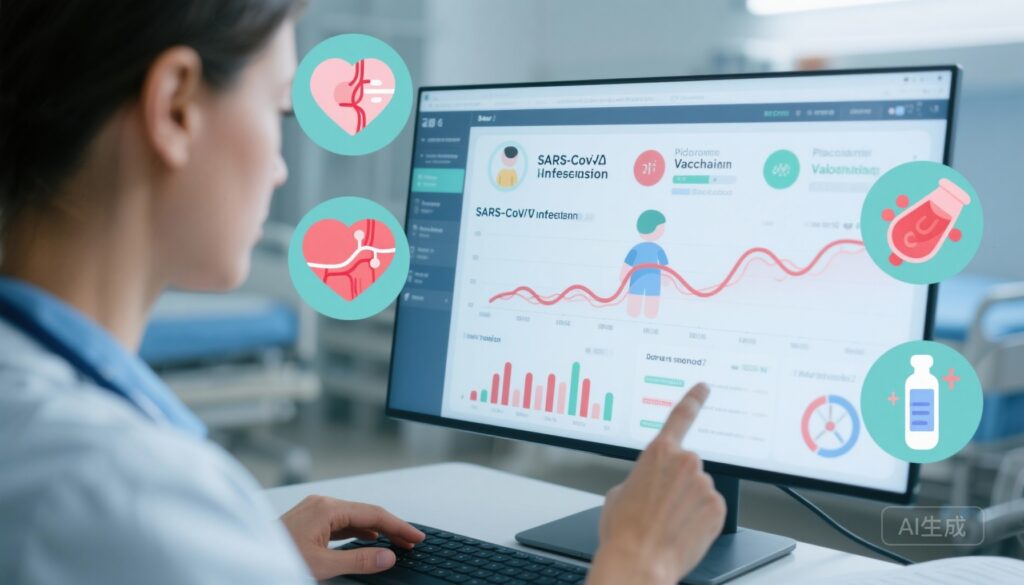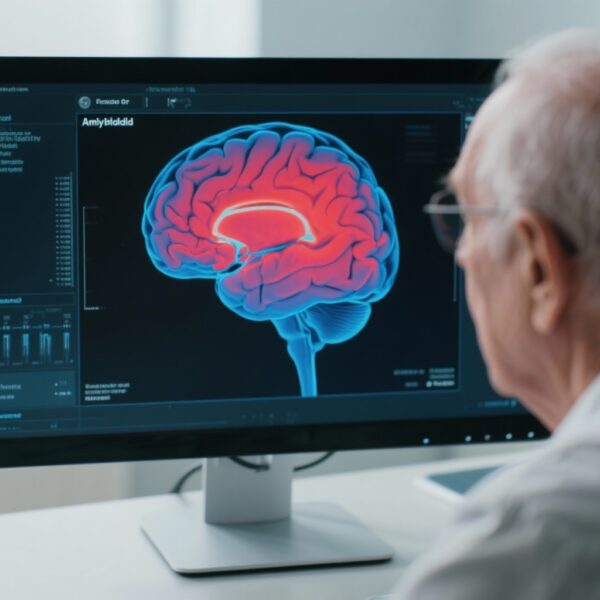Highlight
– In a whole-population English cohort of 13.9 million children and young people (CYP) aged <18 years, first SARS‑CoV‑2 diagnosis was associated with markedly increased risks of rare arterial and venous thrombotic events, thrombocytopenia, myocarditis/pericarditis, and inflammatory syndromes—especially in the first week after diagnosis.
– The risk after infection declined over time but remained elevated beyond 12 months for venous thromboembolism, thrombocytopenia, and myocarditis/pericarditis.
– First-dose BNT162b2 vaccination produced a smaller, short-term increased risk of myocarditis or pericarditis within 4 weeks; the absolute excess risk attributable to vaccination was substantially lower than that attributable to infection.
Background
Decisions about SARS‑CoV‑2 vaccination in children and adolescents weigh the low frequency of severe outcomes following infection against rare but well-publicized vaccine-associated adverse events. Myocarditis and pericarditis after mRNA vaccination, and the thromboinflammatory manifestations of COVID‑19 including multisystem inflammatory syndrome in children (MIS‑C/PIMS‑TS), have both raised safety and policy questions. Robust population-level estimates comparing the risks of vascular and inflammatory events after infection versus after vaccination in CYP are therefore crucial for clinical counseling and public health policy.
Study design
The reported investigation by Sampri et al. used linked, whole-population electronic health records in England to create a retrospective cohort of all individuals <18 years registered with a general practitioner and with known demographic data from Jan 1, 2020, to Dec 31, 2022. Outcomes included arterial thrombotic events, venous thrombotic events (VTE), thrombocytopenia, myocarditis or pericarditis, and inflammatory conditions. The exposure was defined either as a first recorded COVID‑19 diagnosis (positive PCR/antigen test or diagnostic code) during Jan 1, 2020–Mar 31, 2022, or a first documented BNT162b2 (Pfizer–BioNTech) vaccination during Aug 6, 2021–Dec 31, 2022.
Hazard ratios adjusted for age, sex, ethnicity, region, deprivation, GP contact frequency, and medication use were estimated by time since event (weeks 1, 2–4, and beyond) comparing periods after diagnosis or vaccination with unexposed time or time before exposure.
Key findings
Population and exposures: Among 13,896,125 CYP (<18 years), 3,903,410 (28.1%) had a recorded COVID‑19 diagnosis. Among 9,245,395 vaccine-eligible CYP aged 5–17 years, 3,407,560 (36.9%) received a first BNT162b2 dose within the study period.
Risks after SARS‑CoV‑2 infection
In the first week after a first recorded COVID‑19 diagnosis (compared with no or pre-diagnosis time), adjusted hazard ratios (aHRs) were markedly increased for multiple outcomes:
- Arterial thromboembolism: aHR 2.33 (95% CI 1.20–4.51)
- Venous thromboembolism: aHR 4.90 (3.66–6.55)
- Thrombocytopenia: aHR 3.64 (2.21–6.00)
- Myocarditis or pericarditis: aHR 3.46 (2.06–5.80)
- Inflammatory conditions (including MIS‑C/PIMS‑TS–type presentations): aHR 14.84 (11.01–19.99)
Risk attenuated during weeks 2–4 but important signals persisted for some outcomes beyond 12 months. Notably, elevated risks remained beyond 12 months for:
- Venous thromboembolism: aHR 1.39 (1.14–1.69)
- Thrombocytopenia: aHR 1.42 (1.01–2.00)
- Myocarditis or pericarditis: aHR 1.42 (1.05–1.91)
These findings imply that a first SARS‑CoV‑2 diagnosis is associated with an acute spike in thromboinflammatory complications and that for a subset of outcomes there is an elevated long-term risk signal.
Risks after BNT162b2 vaccination
Comparing post-vaccination time with no or pre-vaccination time, first-dose BNT162b2 vaccination was associated with an increased hazard of myocarditis or pericarditis within the first 4 weeks (aHR 1.84, 95% CI 1.25–2.72). Other vascular or inflammatory outcomes were not reported as significantly increased after vaccination in this dataset.
Absolute excess risk estimates over 6 months were provided for myocarditis or pericarditis: 2.24 (1.11–3.80) per 100,000 individuals after infection versus 0.85 (0.07–1.91) per 100,000 after vaccination. These absolute numbers emphasize the rarity of events overall and the substantially greater myocarditis/pericarditis burden following infection compared with vaccination in this cohort.
Clinical interpretation and implications
The study provides population-level, comparative evidence that first SARS‑CoV‑2 infection in CYP confers higher and more persistent risks of several rare vascular and inflammatory outcomes than receipt of a first BNT162b2 dose. The markedly elevated short-term risk of inflammatory syndromes and VTE after infection—together with a higher absolute risk of myocarditis/pericarditis after infection than after vaccination—supports the risk–benefit balance favoring vaccination to reduce the overall burden of these rare but potentially serious complications.
For clinicians counseling families, the data can be summarized as follows: events such as myocarditis or pericarditis are rare after either infection or vaccination, but infection confers a higher short-term and longer-term risk for a range of thromboinflammatory conditions. Vaccination reduces the likelihood of infection (and severe infection), and therefore of the greater downstream risks linked to SARS‑CoV‑2.
Mechanistic considerations
SARS‑CoV‑2 infection can trigger systemic inflammation, endothelial activation, and a prothrombotic state, underpinning increased VTE and thrombotic arterial events. Post-infectious hyperinflammatory conditions in children (MIS‑C/PIMS‑TS) reflect dysregulated immune responses. Myocarditis associated with either infection or vaccination likely reflects immune-mediated injury; infection-associated myocarditis is plausibly driven by direct viral effects and by a broader inflammatory milieu, which may explain the higher absolute risk after infection compared with vaccine-associated myocarditis, which typically has milder clinical courses in adolescents and young adults.
Strengths and limitations
Strengths include near-complete, national-level coverage using linked electronic health records, large sample size, adjustment for several confounders, and time-stratified hazard estimation allowing acute and longer-term risk windows to be examined.
Key limitations are inherent to retrospective EHR analyses: potential misclassification of exposures and outcomes, under-ascertainment of asymptomatic infections or tests performed outside healthcare settings, residual confounding, and inability to capture unrecorded health-seeking behaviour fully. The study evaluated first documented vaccination (predominantly BNT162b2) and may not be generalizable to other vaccine types, booster doses, or to different SARS‑CoV‑2 variants circulating after the study period. Finally, although absolute risks were quantified for myocarditis/pericarditis, less frequent outcomes yield wide confidence intervals and limit precision for subgroup analyses (e.g., by age or sex). The authors note an erratum to the original article; readers should consult the corrected publication for technical details.
Expert commentary and guideline context
National immunization advisory groups, including the UK Joint Committee on Vaccination and Immunisation (JCVI) and public-health bodies such as the US Centers for Disease Control and Prevention (CDC), have balanced these kinds of risks in recommending vaccination for eligible children and adolescents—particularly where benefits in reducing infection, severe disease, and complications (including MIS‑C) outweigh rare vaccine-associated adverse events. The present findings align with multiple prior reports that infection-associated myocarditis and other complications can exceed vaccine-associated risks when considered on a population scale.
Practice and policy takeaways
- When counseling parents or adolescents, emphasize absolute event rates: myocarditis/pericarditis and thrombotic events remain rare, but risk after infection is larger than after vaccination.
- Vaccination strategies that reduce infection incidence will likely reduce the population burden of post-infectious vascular and inflammatory complications in CYP.
- Ongoing surveillance is essential: changes in circulating variants, vaccine formulations, age groups, and booster policies require updated safety-effectiveness assessments.
Conclusion
This large, population-based EHR study from England shows that first SARS‑CoV‑2 diagnosis in children and adolescents is associated with higher short-term and some persistent long-term risks of rare vascular and inflammatory diseases than those observed after first-dose BNT162b2 vaccination. Although myocarditis/pericarditis risk increases modestly in the month after vaccination, the absolute excess risk is substantially lower than the risk after infection. These data strengthen the evidence base supporting vaccination of eligible CYP as a public-health strategy to mitigate the greater and more persistent complications associated with SARS‑CoV‑2 infection.
Funding and clinicaltrials.gov
Funding: Wellcome Trust, British Heart Foundation Data Science Centre, and Health Data Research UK (as reported by the authors).
ClinicalTrials.gov: Not applicable (retrospective observational cohort study using routine health data; no trial registration number reported).
Selected references
1. Sampri A, Shi W, Bolton T, et al.; CVD‑COVID‑UK/COVID‑IMPACT Consortium. Vascular and inflammatory diseases after COVID‑19 infection and vaccination in children and young people in England: a retrospective, population‑based cohort study using linked electronic health records. Lancet Child Adolesc Health. 2025;9(12):837–847. doi:10.1016/S2352-4642(25)00247-0. Erratum in: Lancet Child Adolesc Health. 2025 Nov 6:S2352-4642(25)00335-9.
2. Feldstein LR, Rose EB, Horwitz SM, et al. Multisystem Inflammatory Syndrome in U.S. Children and Adolescents. N Engl J Med. 2020;383(4):334–346. doi:10.1056/NEJMoa2021680.
3. Centers for Disease Control and Prevention. Myocarditis and Pericarditis Following mRNA COVID‑19 Vaccination. CDC website. Updated information and guidance available at: https://www.cdc.gov/vaccines/covid-19/clinical-considerations/myocarditis.html (accessed 2025).
4. UK Health Security Agency / Joint Committee on Vaccination and Immunisation (JCVI). COVID‑19 vaccination guidance for children and young people. Official guidance and statements available at: https://www.gov.uk/government/collections/jcvi-advice-on-covid-19-vaccination (accessed 2025).
Readers seeking more granular subgroup analyses, age- and sex-specific estimates, or the erratum details should consult the primary Lancet publication and supplementary materials linked therein.



